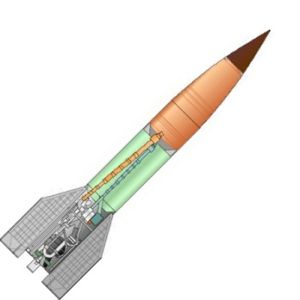
Home - Search - Browse - Alphabetic Index: 0- 1- 2- 3- 4- 5- 6- 7- 8- 9
A- B- C- D- E- F- G- H- I- J- K- L- M- N- O- P- Q- R- S- T- U- V- W- X- Y- Z
Super V-2
 Super V-2 Credit: © Mark Wade |
AKA: Project 4212. Status: Cancelled 1947. Payload: 1,000 kg (2,200 lb). Thrust: 392.00 kN (88,125 lbf). Gross mass: 20,000 kg (44,000 lb). Height: 14.50 m (47.50 ft). Diameter: 1.65 m (5.41 ft). Span: 3.60 m (11.80 ft). Location: Vernon.
In on 12 June 1945, only weeks after the end of the second World War, the newly reconstituted French Ministry of War created CEPA (Centre for Study of Guided Missiles). Its objective was to acquire for France the rocket technology developed in Germany during the war, especially that of the V-2. Between May and September 1946 the government of France recruited an initial group of over thirty German engineers for this purpose, eventually settling them at a remote site at Vernon, the Laboratory for Ballistic and Aerodynamic Research (LRBA). In August 1946 this group already sketched out the development steps that would lead to the Ariane rocket of the 1980's.
A two phase program was conceived. First the necessary production base and test facilities for French production of the V-2 would be created in France. This would be followed by development and production of the A9, the planned V-2 follow-on designed at Peenemuende during the war.
During the course of 1946 the first phase of the project was put into motion. About 75% of the parts necessary for construction of 30 V-2's were acquired from French subcontractors for the rocket or supplies in the French zone of occupation in Germany. A site near the town of Gramat in the Alzou Mountains was selected for engine stand tests. A survey team went to Algeria in November 1946 and selected a site near Colomb-Bechar for V-2 flight tests.
However by early 1947 problems with implementing the first phase were clear. The American and Russian 'allies' would not co-operate in providing key V-2 components the French needed to complete the 30 V-2's. It would not be possible to have the necessary infrastructure completed in France and Algeria to allow new-build V-2 flight tests to begin any earlier than 1952. By that time it was expected the rocket would be obsolete technology. Therefore it was decided to proceed on a dual track, still with the objective of beginning flight tests in 1952. The German team at LRBA would assist in French development and flight test of the A9 rocket, picking up from where the design had been at Peenemuende in 1944, under the project 4211. Another team under Jean-Jacques Barre would pursue the elaboration of his 'pure French' 1941 rocket design, under the project 4212.
The development plan for the 'Super V-2' rocket envisioned preserving the aerodynamic shape and size of the V-2, but using a more powerful engine with 40 metric tons thrust. The design then would be progressively improved to use pump-fed storable propellants and improved structural and engine arrangements until a strategic-range weapon was achieved. The steps envisioned in 1946-1947 were:
- R1 - 1000 kg warhead over a 1500 km range. Propellants nitric acid and kerosene, pressure-fed by a gas generator. Test of the new propellant combination.
- R2 - 1000 kg warhead over a 1400 km range. Propellants liquid oxygen and kerosene, turbopump-fed engine.
- R2S - 1000 kg warhead over an 1800 km range, or 500 kg over a 2250 km range. Propellants nitric acid and kerosene, turbopump-fed engine. This would be the basic production strategic weapon, introducing the complete new technology package -- pump-fed storable propellants and a vastly improved empty weight fraction.
- R2M - 1000 kg warhead over a 3600 km range. Propellants nitric acid and kerosene, turbopump-fed engine. Two solid propellant booster engines were to assist on take-off, and the rocket would have glide capability to extend range using aerodynamic lift. This was the final realization of the A9 design concept.
The project went through a thorough theoretical study and design of the rocket, tests and investigations on the handling and storage of nitric acid, and stand tests of the gas generator for the 40 metric ton engine. But there was no government interest in providing the substantial funding necessary to bring a prototype to flight status. The Super V-2 was cancelled in 1948 and the team concentrated on development of the one-tenth scale Project 4213 / Veronique with a 4 metric ton thrust motor. However the Super V-2 studies showed the way. Veronique began flights in 1950, beating the 'all-French' Eole by two years. Veronique set the course for rocket development and propellant selection in France that would finally lead to the Ariane space booster twenty years later.
Maximum range: 1,800 km (1,100 mi). Alternate warhead: 500 kg (1,100 lb). Maximum range with alternate warhead: 2,250 km (1,390 mi).
Family: IRBM. Country: France. Agency: LRBA. Bibliography: 394, 8688.
Back to top of page
Home - Search - Browse - Alphabetic Index: 0- 1- 2- 3- 4- 5- 6- 7- 8- 9
A- B- C- D- E- F- G- H- I- J- K- L- M- N- O- P- Q- R- S- T- U- V- W- X- Y- Z
© 1997-2019 Mark Wade - Contact
© / Conditions for Use